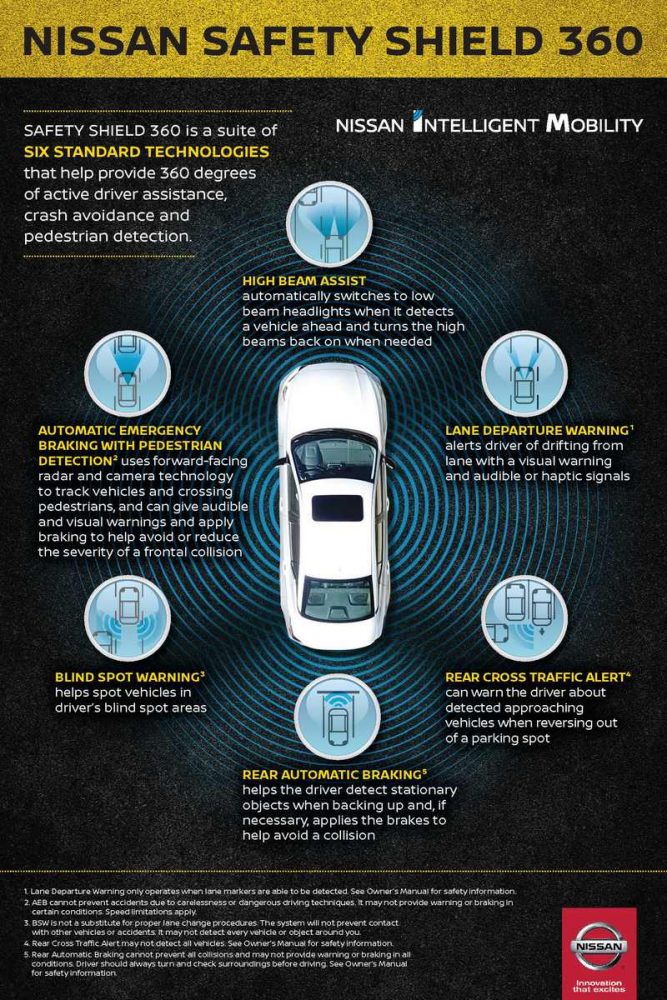 Nissan’s ProPILOT™ Assist technology on the Rogue SUV
Nissan’s ProPILOT™ Assist technology on the Rogue SUV
Photo: Nissan
Safety features in cars fall into one of two buckets: active safety and passive safety. But what’s the difference and how do they work together to help protect you and your fellow drivers on the road?
Safety First: Nissan’s SUV lineup offers Nissan Safety Shield 360 suite of active safety features
Any safety feature designed to only spring into action when you need them. A good example of a passive safety feature is the airbag. You know it’s there, but the chances you will ever see it are slim. Airbags hang out in wait and only deploy if you are in a collision. Therefore, when you’re driving day to day, you don’t notice they are there because they are passive.
The same goes for seatbelts. Sure, you need to buckle up every time you get behind the wheel, but you barely feel your seatbelt once it’s fastened. But if you brake suddenly, your seatbelt will lock up and keep you in place in your seat, preventing you from being propelled through the windshield. Seatbelts, therefore, are another example of passive safety technology.
What makes active safety technology different is that instead of helping you deal with accidents when they occur, it tries to help you avoid them altogether. The systems are constantly active, monitoring the road and your driving and intervening when deemed necessary.
 Nissan SafetyShield360 is an example of active safety technology
Nissan SafetyShield360 is an example of active safety technology
Photo: Nissan
Features such as cross-traffic alert, blind-spot assistance, collision mitigation braking, lane keeping assist, and electronic stability control are all designed to prevent accidents by either enhancing the driver’s awareness, warning them of potential accidents, or influencing the vehicle’s behavior directly.
Active safety features use sensors like cameras and radar to detect potential hazards and reacting accordingly. In cars equipped with adaptive cruise control, you set the speed you want to travel and the distance you want to keep between you and the car in front, and the system uses cameras and radar to speed up and slow down when needed. This helps the driver use cruise control even when roads are busy; with regular cruise control the driver would need to brake if the car was approaching a slower-moving vehicle.
In the case of forward collision warning, the car will sense if you are approaching a car or other object too quickly and sound an alert or vibrate your seat or steering wheel to alert you. If you don’t take any action to mitigate the situation, the car will brake automatically to either help you avoid the collision entirely, or at least lessen the severity of the collision by helping it occur at a slower speed.
Active safety features are becoming more advanced with each model year, which will hopefully help decrease the number of fatal accidents on U.S. roads each year.
Safe Cars for Teens: Nissan Altima and Murano score top marks for newer drivers
When designed properly and functioning as desired, these technologies can be truly powerful. Accidents will always happen, but now we can do more than just make sure we survive them — we can also make our cars actively help you avoid them.
Catherine Hiles (she/her) is a native Brit living and working in Dayton, Ohio. Cat has written about a variety of subjects, including finance, cars, and parenting. She is a frequent contributor to Dayton Mom Collective, The Penny Hoarder, and WDW Magazine.
Cat lives with her husband, their two kids, and their energetic pitbull mix. She counts running, lifting weights, walking, and reading among her hobbies. See more articles by Cat.



